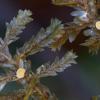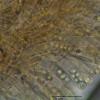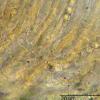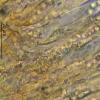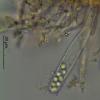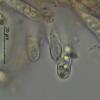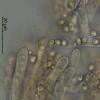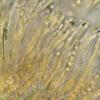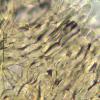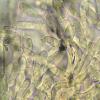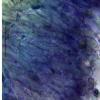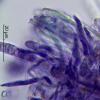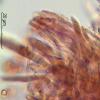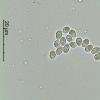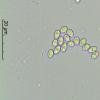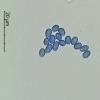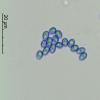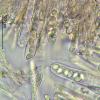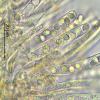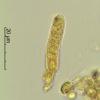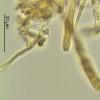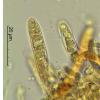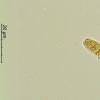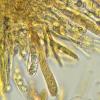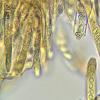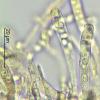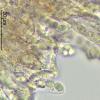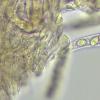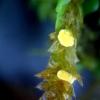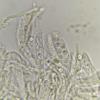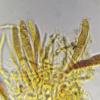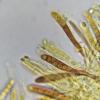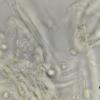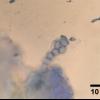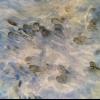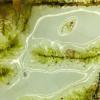
24-12-2025 17:08
Hulda Caroline HolteHello, I have found this propoloid ascomycete on

21-12-2025 09:32
Hello.A tiny ascomycete found embedded in wood in

21-12-2025 21:32
Pol DebaenstHello, Garden, Burgweg 19, Veurne, BelgiumOn 10/1

22-12-2025 23:38
Patrice TANCHAUDBonsoir, récolte sur un mur en pierre, apothéci

22-12-2025 00:47
Patrice TANCHAUDBonsoir, récolte à proximité du milieu dunaire

Hola a todos.
Subo unas fotos de un asco que hemos encontrado hoy sobre musgos encima de una madera de Boj.
Esporas mayoritariamente con 2 gútulas, verrugosas, de 4-5 x 2,5-3 micras.
Ascas NO amiloides, pleurorrincas.
Paráfisis con muchas VBs.
Excípulo también con abundantes VBs.
En el monte pensé en una especie de Bryoscyphus, pero ahora no sé que puede ser.
¿Podrían ayudarnos?
Gracias
Rubén

This is a very interesting collection. I consider it a Pithyella.
Do you have a photo of a dead ascus apex, unopened and not too immature? I want to know if there is an apical or lateral wall thickening.
I see at the moment only Pithyella apicalis as closest, which is from ceylon and has more roundish spores with stronger warts.
Bryoscyphus may well be a synonym of Pithyella, that needs to be brought out. If you want to contribute to this question, please give this for DNA.
And did you find out the name of the moss? If not, please make some microscopic photos of it.
Zotto

Hello Ruben,
very nice collection. Before I read Zottos text I was also thinking of Pithyella. Regarding the moss: it would perhaps also be good to have a foto of the moss in the habitat. As far as I understood it grew on a log of Buxus sempervirens (boj)? Is the surrounding area more acid or base-rich?
Best regards, Lothar

Hola Zotto, Lothar.
¿Qué tal están? Yo he estado un poco ocupado unos meses, pero he leído casi todos los mensajes.
Gracias por sus respuestas.
He mirado y no tengo buena foto de ápice de asca muerta, pero tengo más apotecios, así que miraré uno más para ver si hago unas fotos mejores.
Envío alguna foto de esporas con agua y con cotton, para ver un poco mejor la ornamentación.
Lothar, yo encontré el musgo enrollado en un tronco de Buxus que estaba todavía vertical donde creció, pero ya estaba casi muerto. Lo moví un poco y se rompió por la base. En la base había peritecios parecidos a Rosellinia o no lo sé, que no llegué a mirar. La misma rama tiene Eutryblidiella hysterina y también Unguiculariopsis ravenelii subsp. hamata, entre otros muchos. Yo fui a buscar Unguiculariopsis ravenelii subsp. hamata.
El tronco estaba a la orilla de un río, y el entorno es todo muy calizo, aunque donde lo encontré había bastante materia orgánica en el suelo y humus.
Esta semana voy a consultar a Javier Martínez-Abaigar, un amigo mío de la Universidad de La Rioja a ver si nos puede ayudar con la identificación del musgo.
Rubén

You must kill the asci, e.g., by adding Melzer's or CB (cotton blue in lactophenol).
Some people have difficulties in viewing living elements, but you are not among them :-)
Zotto

Hola a todos.
La especie del musgo hospedante es Neckera complanata (Hedw.) Huebener.
Zotto, mañana miro al micro otro apotecio con Melzer a ver si se observa alguna diferencia en el ápice ascal.
Saludos
Rubén

Neckera is what I expexted - for N. complanata (the most common species) I missed the "flagella-branches" (or similar - directly translated to English). It ist a moss that is common also in Germany, but only in base-rich regions (my question ...), mainly on rocks but also on standing trees.
At any case - I will look for your fungus on Neckera in future!
Best regards, Lothar

Hola Lothar.
A ver si tiene suerte y encuentra algunos apotecios sobre Neckera.
Saludos
Rubén
A correspondent has found what could be the same as this also on Neckera in a humid location in Wales, UK. He is sending it to me so I will provide documentation following this post.
Did you manage to get any further with this collection? Was it sequenced in the end?
Thanks and best wishes,
George

I will try to collect tissue from the sample for sequencing ITS and LSU. I have already got some of P. chalaudii in the freezer for the same purpose, so perhaps we will be able to get a bit more understanding of where they really belong (if it works).
But I will try to produce good documentation of the living material as well.
There is a lot of suitable habitat (Neckera complanata growing on roots in streams) in my area so it is very possible that it is around here as well. Hopefully I will have some time to search.
Thanks again and I will update in due course,
George


Best, Lothar

did anyone study the infectious structures of these fungi? In Octospora-like fungi it is often very distinct which parts of the bryophyte are infected and how. But I don't know whether this character is this important with inoperculates too.
Viktorie
I will try to examine this with host stem and leaf sections.
George

thank you very much for your response!
So I think I will try when the weather has become warmer here.
Yours, Lothar

according to Peter Döbbeler, it's much more difficult to study infection in inoperculate bryophilous ascomycetes than in Pezizales. Some time ago I had asked him whether he could study and illustrate inf.structures for a paper on one of such fungi, and he explained that inf.str. in inoperculate ascos are not so characteristic, so you cannot be sure that the hyphae really belong to a certain species (the moss can be inhabited by several species, although not all of them, of course, produce fruit bodies in the same time).
Zuzka

Vaya George, espero que se recupere pronto.
Yo tengo el material de esta recolecta por si ustedes quieren hacer ADN o cualquier otra prueba. Pueden disponer de él como si fuera de ustedes.
Zuzana, no miré la infección en hojas del hospedante, pero este sábado voy a ir al mismo lugar a ver si por casualidad vuelvo a encontrar algunos apos. No será fácil, pero que no sea por no haberlo intentado.
Salud
Rubén
As you say, Zuzana, the hyphae are inconspicuous and also nondescript. I made sections beside the apothecia (on upper parts of the shoot less likely to have many fungi) and saw narrow (±1.5), thin-walled hyaline hyphae on the leaf surfaces. The host stems seemed empty. Also, the hyphae didn't seem to take up the lactophenol cotton blue well, which is ususual.
Rubén, I would be happy to include your collection in my sequencing batch. Also great to have collections from a broad geographical range. I will e-mail you separately.
All the best,
George
